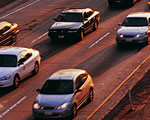 Go to main content
Go to main content
Archive Website of the UK government
Please note that this website has a UK government accesskeys system.
Main menu
Page menu
Environment and greener living

Car sharing

With more cars on the roads, car sharing schemes are becoming more popular. Car sharing can help combat congestion and reduce CO2 emissions, as well as saving you money. You can car share on most journeys, from regular commutes to one-off events.
What is car sharing?
Car sharing is when two or more people travel together by car for all or part of a trip. One of the people travelling is usually the owner of the vehicle and the other(s) usually make a contribution towards fuel costs.
Car sharing may be formal, using an organised car share scheme, or informal – for example, friends or colleagues travelling to work together.
When you can car share
Nearly every journey has the potential for car sharing:
- regular journeys – like going to work or taking the children to school
- one-off trips – like going to an event, festival or show that many other people are attending
How to car share
There are a number of easy ways to car share:
- you could set up an informal arrangement with family, friends or colleagues
- some organisations or businesses arrange car sharing for their employees – ask if this is available where you work
- there are organised schemes available to everyone which operate over the internet
To find an organised scheme in your area, check your local council website. Alternatively, Carplus (a charity that promotes responsible car use) lists local schemes.
Even if you don’t drive, you can still car share. Sixty per cent of car drivers would be willing to share a car to work if there was someone suitable to travel with.
The benefits of car sharing
The benefits of car sharing include:
- reduced fuel costs and parking fees
- increased personal security if your car share means you walk to and from the car with somebody else
- better air quality and lower carbon emissions due to reduced traffic
- less congestion and shorter journeys due to fewer cars being on the road
- an increased chance of finding a parking space, because fewer cars means less competition for spaces
An average car commuter drives 12 miles a day. Cutting that by half through car sharing saves around 400 kilograms of carbon dioxide over one year, or about 170 litres of petrol.
Is car sharing safe?
Some people find car sharing gives them increased personal security when walking to and from the car.
The major car share companies take safety very seriously and provide guidelines to members. Remember that security should be a key part of any car share arrangement.
You can get more advice on personal safety from the Suzy Lamplugh Trust.
Insurance and car sharing
The Association of British Insurers says that car sharing won't affect the insurance of their members as long as:
- the vehicle seats no more than eight passengers
- a profit isn't made from any payment by passengers
However, if you have any concerns, you should check with your insurance company, as terms and conditions may vary between insurance providers.
Car sharing lanes
Car sharing lanes (also known as high occupancy vehicle or HOV lanes) are designed for vehicles with more than one occupant. They are being introduced in areas that experience high congestion levels, in order to encourage car sharing. Cameras are used to ensure that only cars containing two or more people use the lanes.
The benefits of using car sharing lanes include:
- drivers in shared cars can avoid congestion
- car sharers' journeys are significantly quicker
- fewer cars on the road mean reduced congestion for all drivers
M606 / M62 car sharing lane
The UK's first motorway car sharing lane was opened in March 2008. It links the southbound M606 near Bradford to the eastbound M62 towards Leeds. The lane is between the southbound M606 and eastbound entry slip road at M62 junction 26. This allows car sharers to avoid congestion at junction 26, and get priority entry onto the M62 eastbound.
As well as cars with at least one passenger, the lane can also be used by:
- coaches and buses
- minicabs and taxis (when carrying passengers)
- motorcycle
For more information on the M606 / M62 car sharing lane and how to get started car sharing, download the leaflet from the Highways Agency.
 Facebook
Facebook Twitter
Twitter StumbleUpon
StumbleUpon Delicious
Delicious Reddit
Reddit